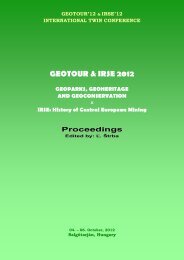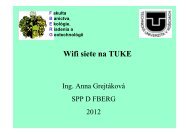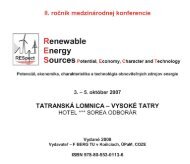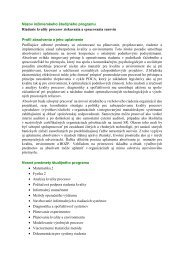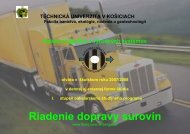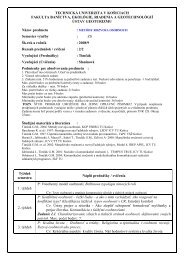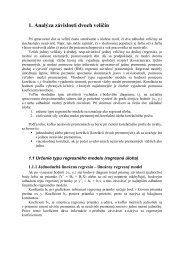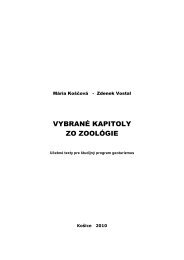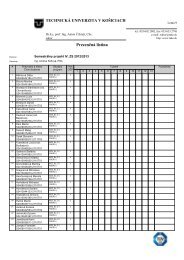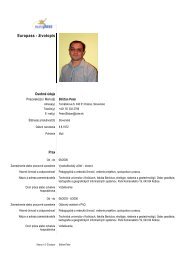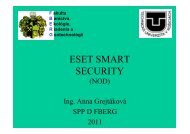GEOTOUR & IRSE 2012.pdf - Fakulta BERG - TUKE
GEOTOUR & IRSE 2012.pdf - Fakulta BERG - TUKE
GEOTOUR & IRSE 2012.pdf - Fakulta BERG - TUKE
Create successful ePaper yourself
Turn your PDF publications into a flip-book with our unique Google optimized e-Paper software.
Salgótarján, 04. – 06. October 2012<br />
processes as the hydrothermal solutions ascending along the fractures of the solidified rocks<br />
decomposed the original rock-forming minerals, and a new, potassium-rich mineral assemblage was<br />
formed (Fig. 2). The results of these processes can be observed N and NE from Telkibánya on the<br />
surface.<br />
The ore mineralization occurs in veins, or in the brecciated host rock of the veins. There are about<br />
20 known and exploited veins with a strike of N-S in the area, in which the minerals were<br />
precipitated from hot hydrothermal solutions accompanying the volcanism. The infill is changing<br />
with depth, according to the increasing temperature of the hydrothermal system. At the top the most<br />
abundant vein mineral is quartz. There are several cm long quartz crystals, the longest ones are 10<br />
cm. Opal and cinnabar also occurs, both in the veins and in the host rock, in minor patches. At<br />
lower levels the veins are filled with clay minerals instead of quartz. The most important ore<br />
minerals (native gold and silver sulphides) are very rarely visible; we can observe these only by<br />
microscope as fine grains in the brecciated host rock or in the veins. The gold is frequently<br />
associated with the much more abundant pyrite. The gold content is low, reaching only a few grams<br />
per one metric ton rock. The silver content can be as high as several g/t. At the bottom level reached<br />
by exploration drillholes only a base metal sulphide mineralization was explored (Székyné Fux<br />
1970, Molnár et al. 2009).<br />
The gold and silver mining in Telkibánya goes back to the 14th century. That time mining took<br />
place on surface, in open pits. The pits (depressions of a few meters across) followed the surface<br />
outcrops of the veins. We can have an impression about the intensity of the open-pit mining<br />
considering the several thousands pits in the area of Kánya Hill and Gyepű Hill.<br />
The underground mining started about two hundred years later, as the near-surface parts were<br />
exhausted. Adits were opened; these days we know about 80 adits in the area, some of which are<br />
still accessible. The ventilation and the transport between the different levels were solved by<br />
vertical shafts. The excavated ore was processed in water-powered ore mills, transported to the<br />
surface through the drainage adits at the bottom level of the mines. However, the yield of the mines<br />
was rather low, and mining was pursued in certain periods in need of precious metals only. Finally,<br />
the mining ceased in the 1850's (Benke 2009, 2011).<br />
After the 2nd World War ore prospecting started again in order to detect new gold and silver<br />
reserves. Although these ore reserves did not prove to be economic, prospecting is still going on,<br />
and the last project was finished in 2001. Beyond surface sampling and soil geochemistry, the cores<br />
of several exploration drillholes were assayed and documented, providing new information on the<br />
rocks and minerals (Zelenka et al. 2009).<br />
Fig. 2 Well formed crystals of adularia, a characteristic K-feldspar<br />
formed by the rock alteration from the Kánya Hill, Telkibánya.<br />
Largest crystals are 4 mm. Photo: Szakáll S.<br />
8



